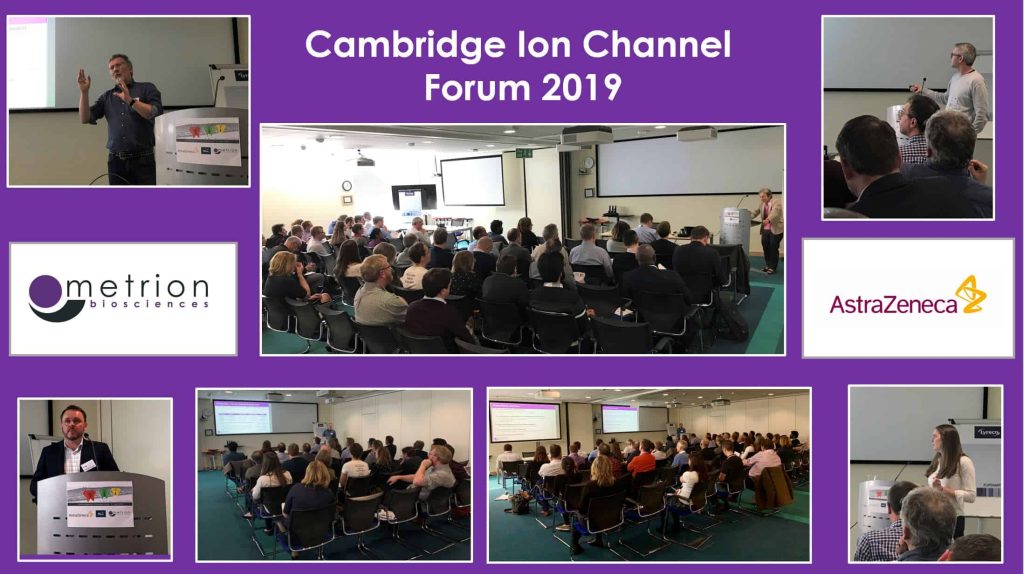Review written by the Editor
AstraZeneca and Metrion Biosciences again joined forces on April 9 to co-host the 6th Cambridge Ion Channel Forum, held at the Milstein building at Granta Park. The event has been a key feature of the ion channel enthusiasts’ calendar since 2011 and attended by around 65 delegates, who also enjoyed a networking lunch and poster session prior to the keynote talk presented by Professor Sarah Lummis from the University of Cambridge.

A study of the molecular function of neurotransmitter-gated ion channels
Sarah’s group study the molecular function of neurotransmitter-gated ion channels, with an emphasis on cys-loop receptors. Her research is focused on both vertebrate and bacterial cys-loop receptors, which includes nicotinic acetylcholine, gamma-aminobutyric acid (GABA), glycine, 5HT3 and glutamate-activated Cl- receptors. Sarah’s talk focused on the prokaryotic ELIC channel from Erwinia Chrysanthemi which is activated by GABA and cysteamine and triggers a stress signal or defence mechanism in plants. CryoEM data for ELIC can be used to probe the structure and function of GABAA receptors.
Sarah concluded with animal and human data on mutations in glycine receptors that cause startle disease or hyperkeplexia. These disturb inhibitory glycine-mediated neurotransmission but remain poorly understood.
Overview of an 8-year drug discovery collaboration
Marc Rogers, CSO of Metrion Biosciences, then presented an overview of an 8-year drug discovery collaboration with a global pharma partner, for which Metrion provided in vitro and ex vivo screening services using their manual patch and automated patch clamp expertise.
During the collaboration, they developed high-quality voltage-gated ion channel assays to reliably identify and profile novel, potent, safe and efficacious state-dependent modulators of a pain-related ion channel target. This yielded a development lead compound and a back-up series with therapeutic potential equal or superior to current clinical treatments.
“It was exciting and highly rewarding to hear some of the latest developments in the field and to see people from academia and industry come together and share their knowledge”.
The development of novel therapies for respiratory diseases
The next speaker was Professor Martin Gosling, the CSO of Enterprise Therapeutics and Professor of Molecular Pharmacology at the University of Sussex. Enterprise focus on the development of novel therapies for respiratory diseases by targeting the underlying mechanisms of mucus congestion, with a focus on Transmembrane Member 16A (TMEM16A) calcium-activated chloride channel and epithelial sodium channels (ENaCs).
Martin presented a case study of TMEM16A, which has recently been proven to behave as a key orchestrator of anion secretion in human airway epithelium. The team started a parallel screening campaign to identify low molecular weight potentiators of TMEM16A using plate-based readers and APC platforms, identifying EXT001 as being particularly efficacious.
This TMEM16A potentiator significantly enhanced the secretory current in cystic fibrosis (CF) patient-derived bronchial epithelial (HBE) cells, with EXT001 promoting mucosal fluid secretion to clinically relevant levels. In collaboration with the Cystic Fibrosis Trust and Cystic Fibrosis Foundation, Enterprise are taking several TMEM16A potentiators into clinical development.
The modulation of GABA-A receptors
Paul Miller from the University of Cambridge then provided insights into the modulation of GABA-A receptors, a ligand-gated chloride channel that mediates fast inhibitory synaptic transmission in brain. As well as being a validated target for anxiety, sleep and addiction, Sage Therapeutics received approval for their GABA-A modulator brexanolone in post-partum depression. GABA receptors possess well-known binding sites in the pore and near the ligand-binding pocket where allosteric modulators like diazepam can bind.
There remains a challenge, however, to develop more selective ligands with diverse chemistry and mechanisms-of-action, and Paul described how his group, in collaboration with Professor Jan Steyaert, have recently raised llama nanobodies against the α1β3 GABA-A receptor. Binding of nanobodies to purified GABA-A proteins is detected using biacore/SPR and patch clamp electrophysiology, with one promising nanobody (Nb38) found to favour the GABA-bound activated state, acting as both an agonist and a potentiator.
Binding of Nb38 helped elucidate the GABA-A receptor structure to 5 angstrom resolution, which was improved to 2.5 angstrom using CryoEM, revealing the two binding sites of Nb38. Paul explained that this work is being extended through generation of a 108 nanobody library.
New cardiac ion channel assays
The session was brought to a close by Verity Talbot with an overview of AstraZeneca’s efforts to develop new cardiac ion channel assays to meet the requirements of the FDA’s CiPA initiative (Comprehensive in Vitro Proarrhythmia Assay). CiPA aims to promote a novel paradigm for assessment of clinical cardiac risk, especially Torsades de Pointes, by combining in vitro ion channel assays and in silico modelling techniques together with translational human tissue assays to facilitate early drug development and compound selection.
Verity described how the FDA selected a training set of 28 compounds of known TdP risk which were screened by pharma companies, CROs (including Metrion), platform providers, academic collaborators and regulatory agencies as part of the CiPA consortium. AZ selected 12 compounds from the toolbox and used them to validate an APC ‘dynamic hERG’ assay utilising the Milnes voltage protocol. They were able to generate kinetic parameters for use in in silico models of action potential duration and to determine qNet scores, finding that combinations of very different hERG binding parameters could estimate similar qNet scores of cardiac arrhythmia risk.
Verity explained that these results are driving ongoing work to assess whether APC kinetic hERG data is predictive of proarrythmic risk and how AstraZeneca will use the CiPA paradigm in their drug discovery process.
It was exciting and highly rewarding to hear some of the latest developments in the field and to see people from academia and industry come together and share their knowledge. We very much look forward to hosting the Cambridge Ion Channel Forum again in 2020, which by then will be in its seventh year, please keep an eye on the Metrion website for further details.
